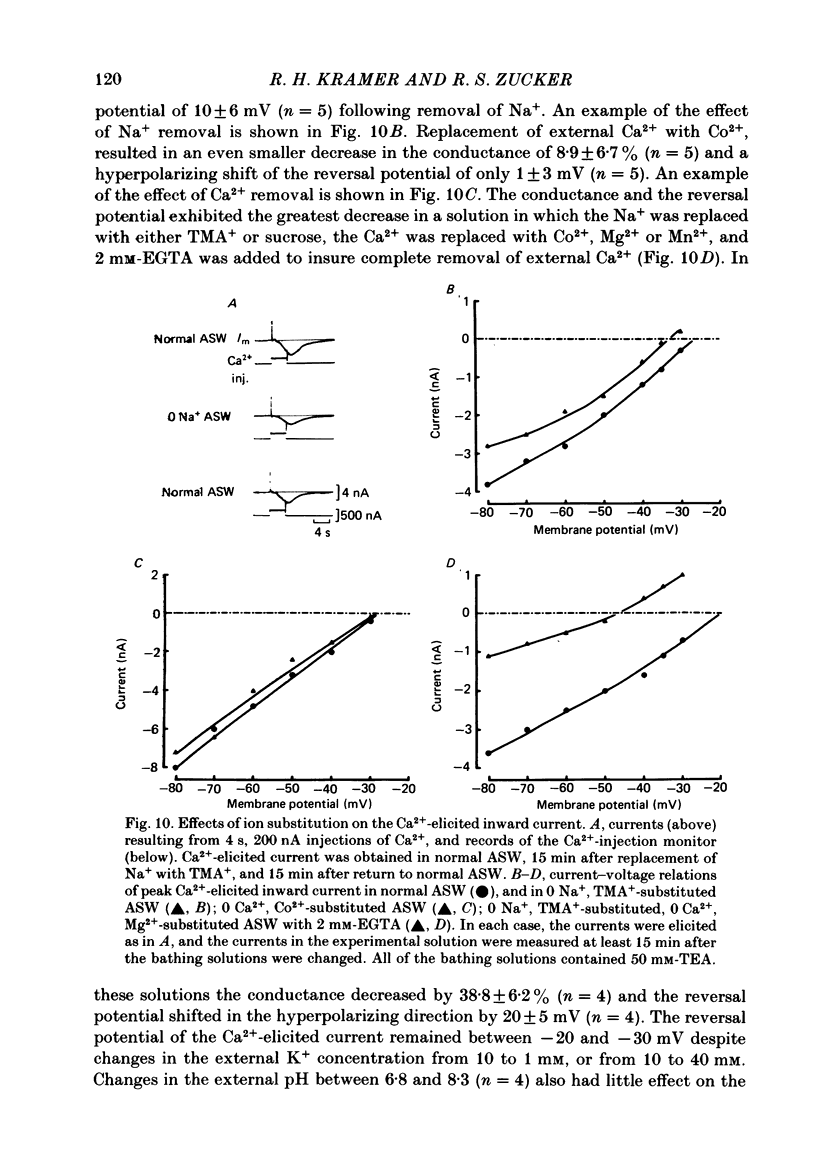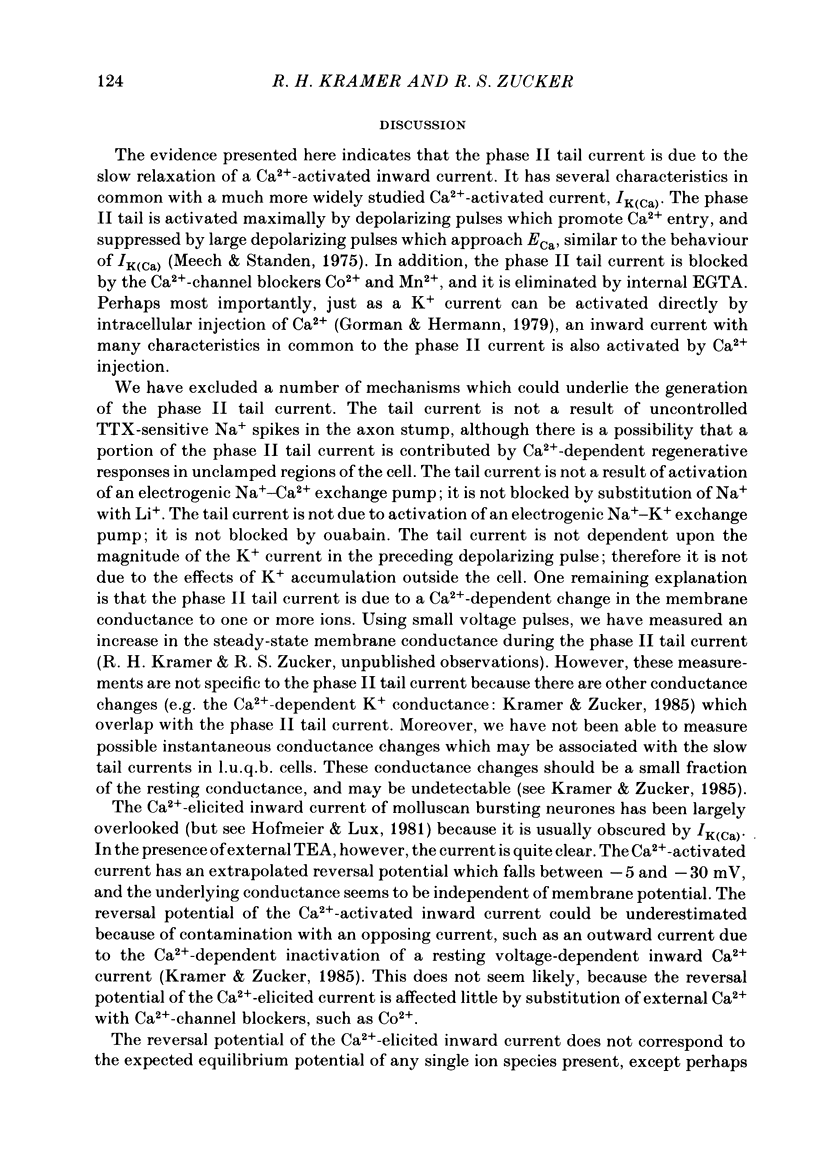Abstract
Depolarizing voltage-clamp pulses elicit a triphasic series of tail currents (phase I, II and III) in Aplysia burst-firing neurones L2-L6. The sequence and time course of the tail currents resemble slow changes in membrane potential which follow bursts in the unclamped cell. The phase II tail current is an inward current with a time course similar to that of the depolarizing after-potential (d.a.p.) which follows bursts in the unclamped cell. The phase II tail current is suppressed by depolarizing pulses which approach ECa, is blocked by Ca2+ current antagonists (Co2+ and Mn2+), and is blocked by intracellular injection of EGTA. The phase II tail current is not blocked by agents which block Na+-dependent action potentials, the Na+-Ca2+ exchange pump, or the Na+-K+ exchange pump. The phase II tail current is not blocked by the elimination of large outward K+ currents which can lead to extracellular K+ accumulation. Thus, the phase II tail current is not generated by any of these processes. The phase II tail current is reduced by about 60% following substitution of tetramethylammonium (TMA+) for external Na+, but is unaffected by reducing external Cl-. The phase II tail current is distinct from a persistent inward Ca2+ current which underlies the negative resistance region of the steady-state current--voltage relation of bursting cells. The persistent inward current is only slightly reduced by TMA+ substitution for Na+, and is enhanced by EGTA injection. Injection of Ca2+ into Aplysia bursting cells elicits a biphasic (inward-outward) current. The inward current can be observed in isolation after blocking the outward component (Ca2+-activated K+ current) with 50 mM-external tetraethylammonium. The Ca2+-elicited inward current has a reversal potential near -22 mV, and is non-selective for Na+, K+ and Ca2+. The reversal potential is unaffected by changes in Cl- and pH. The Ca2+- activated conductance is apparently voltage independent. We propose that the phase II tail current, and hence the d.a.p., is due to the Ca2+-dependent activation of a voltage-independent non-specific cationic conductance. This conductance participates in generating the depolarizing phase of bursting pace-maker activity.
Full text
PDF























Selected References
These references are in PubMed. This may not be the complete list of references from this article.
- Adams D. J., Gage P. W. Ionic currents in response to membrane depolarization in an Aplysia neurone. J Physiol. 1979 Apr;289:115–141. doi: 10.1113/jphysiol.1979.sp012728. [DOI] [PMC free article] [PubMed] [Google Scholar]
- Adams W. B., Levitan I. B. Voltage and ion dependences of the slow currents which mediate bursting in Aplysia neurone R15. J Physiol. 1985 Mar;360:69–93. doi: 10.1113/jphysiol.1985.sp015604. [DOI] [PMC free article] [PubMed] [Google Scholar]
- Adams W. B. Slow depolarizing and hyperpolarizing currents which mediate bursting in Aplysia neurone R15. J Physiol. 1985 Mar;360:51–68. doi: 10.1113/jphysiol.1985.sp015603. [DOI] [PMC free article] [PubMed] [Google Scholar]
- Akaike N., Brown A. M., Dahl G., Higashi H., Isenberg G., Tsuda Y., Yatani A. Voltage-dependent activation of potassium current in Helix neurones by endogenous cellular calcium. J Physiol. 1983 Jan;334:309–324. doi: 10.1113/jphysiol.1983.sp014496. [DOI] [PMC free article] [PubMed] [Google Scholar]
- Alving B. O. Spontaneous activity in isolated somata of Aplysia pacemaker naurons. J Gen Physiol. 1968 Jan;51(1):29–45. doi: 10.1085/jgp.51.1.29. [DOI] [PMC free article] [PubMed] [Google Scholar]
- Andrew R. D., Dudek F. E. Burst discharge in mammalian neuroendocrine cells involves an intrinsic regenerative mechanism. Science. 1983 Sep 9;221(4615):1050–1052. doi: 10.1126/science.6879204. [DOI] [PubMed] [Google Scholar]
- Blankenship J. E., Wachtel H., Kandel E. R. Ionic mechanisms of excitatory, inhibitory, and dual synaptic actions mediated by an identified interneuron in abdominal ganglion of Aplysia. J Neurophysiol. 1971 Jan;34(1):76–92. doi: 10.1152/jn.1971.34.1.76. [DOI] [PubMed] [Google Scholar]
- Blaustein M. P., Hodgkin A. L. The effect of cyanide on the efflux of calcium from squid axons. J Physiol. 1969 Feb;200(2):497–527. doi: 10.1113/jphysiol.1969.sp008704. [DOI] [PMC free article] [PubMed] [Google Scholar]
- Brehm P., Eckert R. Calcium entry leads to inactivation of calcium channel in Paramecium. Science. 1978 Dec 15;202(4373):1203–1206. doi: 10.1126/science.103199. [DOI] [PubMed] [Google Scholar]
- Calabrese R. L. The roles of endogenous membrane properties and synaptic interaction in generating the heartbeat rhythm of the leech, Hirudo medicinalis. J Exp Biol. 1979 Oct;82:163–176. doi: 10.1242/jeb.82.1.163. [DOI] [PubMed] [Google Scholar]
- Carnevale N. T., Wachtel H. Two reciprocating current components underlying slow oscillations in Aplysia bursting neurons. Brain Res. 1980 May;203(1):45–65. doi: 10.1016/0165-0173(80)90003-x. [DOI] [PubMed] [Google Scholar]
- Colquhoun D., Neher E., Reuter H., Stevens C. F. Inward current channels activated by intracellular Ca in cultured cardiac cells. Nature. 1981 Dec 24;294(5843):752–754. doi: 10.1038/294752a0. [DOI] [PubMed] [Google Scholar]
- Connor J. A., Stevens C. F. Voltage clamp studies of a transient outward membrane current in gastropod neural somata. J Physiol. 1971 Feb;213(1):21–30. doi: 10.1113/jphysiol.1971.sp009365. [DOI] [PMC free article] [PubMed] [Google Scholar]
- Coyer P. E., Halsey J. H., Jr, Strong E. R. Reversible changes in the intracellular potassium ion activities and membrane potentials of Aplysia L2-L6 neurones in response to normoxia and hypoxia. J Exp Biol. 1983 Jan;102:79–92. doi: 10.1242/jeb.102.1.79. [DOI] [PubMed] [Google Scholar]
- DiPolo R., Beaugé L. The calcium pump and sodium-calcium exchange in squid axons. Annu Rev Physiol. 1983;45:313–324. doi: 10.1146/annurev.ph.45.030183.001525. [DOI] [PubMed] [Google Scholar]
- Eaton D. C. Potassium ion accumulation near a pace-making cell of Aplysia. J Physiol. 1972 Jul;224(2):421–440. doi: 10.1113/jphysiol.1972.sp009903. [DOI] [PMC free article] [PubMed] [Google Scholar]
- Eckert R., Lux H. D. A voltage-sensitive persistent calcium conductance in neuronal somata of Helix. J Physiol. 1976 Jan;254(1):129–151. doi: 10.1113/jphysiol.1976.sp011225. [DOI] [PMC free article] [PubMed] [Google Scholar]
- Eckert R., Tillotson D. L. Calcium-mediated inactivation of the calcium conductance in caesium-loaded giant neurones of Aplysia californica. J Physiol. 1981 May;314:265–280. doi: 10.1113/jphysiol.1981.sp013706. [DOI] [PMC free article] [PubMed] [Google Scholar]
- Gainer H. Electrophysiological behavior of an endogenously active neurosecretory cell. Brain Res. 1972 Apr 28;39(2):403–418. doi: 10.1016/0006-8993(72)90444-1. [DOI] [PubMed] [Google Scholar]
- Gorman A. L., Hermann A. Internal effects of divalent cations on potassium permeability in molluscan neurones. J Physiol. 1979 Nov;296:393–410. doi: 10.1113/jphysiol.1979.sp013012. [DOI] [PMC free article] [PubMed] [Google Scholar]
- Gorman A. L., Hermann A. Quantitative differences in the currents of bursting and beating molluscan pace-maker neurones. J Physiol. 1982 Dec;333:681–699. doi: 10.1113/jphysiol.1982.sp014475. [DOI] [PMC free article] [PubMed] [Google Scholar]
- Gorman A. L., Hermann A., Thomas M. V. Ionic requirements for membrane oscillations and their dependence on the calcium concentration in a molluscan pace-maker neurone. J Physiol. 1982 Jun;327:185–217. doi: 10.1113/jphysiol.1982.sp014227. [DOI] [PMC free article] [PubMed] [Google Scholar]
- Gorman A. L., Thomas M. V. Intracellular calcium accumulation during depolarization in a molluscan neurone. J Physiol. 1980 Nov;308:259–285. doi: 10.1113/jphysiol.1980.sp013471. [DOI] [PMC free article] [PubMed] [Google Scholar]
- Gorman A. L., Thomas M. V. Potassium conductance and internal calcium accumulation in a molluscan neurone. J Physiol. 1980 Nov;308:287–313. doi: 10.1113/jphysiol.1980.sp013472. [DOI] [PMC free article] [PubMed] [Google Scholar]
- Graubard K. Voltage attenuation within Aplysia neurons: the effect of branching pattern. Brain Res. 1975 May 2;88(2):325–332. doi: 10.1016/0006-8993(75)90394-7. [DOI] [PubMed] [Google Scholar]
- Gähwiler B. H., Dreifuss J. J. Phasically firing neurons in long-term cultures of the rat hypothalamic supraoptic area: pacemaker and follower cells. Brain Res. 1979 Nov 9;177(1):95–103. doi: 10.1016/0006-8993(79)90920-x. [DOI] [PubMed] [Google Scholar]
- Hagiwara S., Byerly L. Calcium channel. Annu Rev Neurosci. 1981;4:69–125. doi: 10.1146/annurev.ne.04.030181.000441. [DOI] [PubMed] [Google Scholar]
- Hermann A., Gorman A. L. External and internal effects of tetraethylammonium on voltage-dependent and Ca-dependent K+ currents components in molluscan pacemaker neurons. Neurosci Lett. 1979 Apr;12(1):87–92. doi: 10.1016/0304-3940(79)91485-x. [DOI] [PubMed] [Google Scholar]
- Hofmeier G., Lux H. D. The time courses of intracellular free calcium and related electrical effects after injection of CaCl2 into neurons of the snail, Helix pomatia. Pflugers Arch. 1981 Sep;391(3):242–251. doi: 10.1007/BF00596178. [DOI] [PubMed] [Google Scholar]
- Johnston D. Voltage clamp reveals basis for calcium regulation of bursting pacemaker potentials in Aplysia neurons. Brain Res. 1976 May 7;107(2):418–423. doi: 10.1016/0006-8993(76)90239-0. [DOI] [PubMed] [Google Scholar]
- Kass R. S., Lederer W. J., Tsien R. W., Weingart R. Role of calcium ions in transient inward currents and aftercontractions induced by strophanthidin in cardiac Purkinje fibres. J Physiol. 1978 Aug;281:187–208. doi: 10.1113/jphysiol.1978.sp012416. [DOI] [PMC free article] [PubMed] [Google Scholar]
- Katz B., Miledi R. A study of synaptic transmission in the absence of nerve impulses. J Physiol. 1967 Sep;192(2):407–436. doi: 10.1113/jphysiol.1967.sp008307. [DOI] [PMC free article] [PubMed] [Google Scholar]
- Kramer R. H., Zucker R. S. Calcium-induced inactivation of calcium current causes the inter-burst hyperpolarization of Aplysia bursting neurones. J Physiol. 1985 May;362:131–160. doi: 10.1113/jphysiol.1985.sp015667. [DOI] [PMC free article] [PubMed] [Google Scholar]
- Lewis D. V., Evans G. B., Wilson W. A. Dopamine reduces slow outward current and calcium influx in burst-firing neuron R15 of Aplysia. J Neurosci. 1984 Dec;4(12):3014–3020. doi: 10.1523/JNEUROSCI.04-12-03014.1984. [DOI] [PMC free article] [PubMed] [Google Scholar]
- Maruyama Y., Peterson O. H. Single-channel currents in isolated patches of plasma membrane from basal surface of pancreatic acini. Nature. 1982 Sep 9;299(5879):159–161. doi: 10.1038/299159a0. [DOI] [PubMed] [Google Scholar]
- Meech R. W. Calcium-dependent potassium activation in nervous tissues. Annu Rev Biophys Bioeng. 1978;7:1–18. doi: 10.1146/annurev.bb.07.060178.000245. [DOI] [PubMed] [Google Scholar]
- Meech R. W., Standen N. B. Potassium activation in Helix aspersa neurones under voltage clamp: a component mediated by calcium influx. J Physiol. 1975 Jul;249(2):211–239. doi: 10.1113/jphysiol.1975.sp011012. [DOI] [PMC free article] [PubMed] [Google Scholar]
- Neher E., Lux H. D. Rapid changes of potassium concentration at the outer surface of exposed single neurons during membrane current flow. J Gen Physiol. 1973 Mar;61(3):385–399. doi: 10.1085/jgp.61.3.385. [DOI] [PMC free article] [PubMed] [Google Scholar]
- Plant T. D., Standen N. B., Ward T. A. The effects of injection of calcium ions and calcium chelators on calcium channel inactivation in Helix neurones. J Physiol. 1983 Jan;334:189–212. doi: 10.1113/jphysiol.1983.sp014489. [DOI] [PMC free article] [PubMed] [Google Scholar]
- Requena J., Mullins L. J. Calcium movement in nerve fibres. Q Rev Biophys. 1979 Aug;12(3):371–460. doi: 10.1017/s0033583500005473. [DOI] [PubMed] [Google Scholar]
- Satin L. Sodium-dependent calcium efflux from single Aplysia neurons. Brain Res. 1984 May 23;300(2):392–395. doi: 10.1016/0006-8993(84)90853-9. [DOI] [PubMed] [Google Scholar]
- Smith S. J., Zucker R. S. Aequorin response facilitation and intracellular calcium accumulation in molluscan neurones. J Physiol. 1980 Mar;300:167–196. doi: 10.1113/jphysiol.1980.sp013157. [DOI] [PMC free article] [PubMed] [Google Scholar]
- Smith T. G., Jr, Barker J. L., Gainer H. Requirements for bursting pacemaker potential activity in molluscan neurones. Nature. 1975 Feb 6;253(5491):450–452. doi: 10.1038/253450a0. [DOI] [PubMed] [Google Scholar]
- Suarez-Kurtz G. The depolarizing afterpotential of crab muscle fibres. A sodium-dependent process mediated by intracellular calcium. J Physiol. 1979 Jan;286:317–329. doi: 10.1113/jphysiol.1979.sp012621. [DOI] [PMC free article] [PubMed] [Google Scholar]
- Tazaki K., Cooke I. M. Isolation and characterization of slow, depolarizing responses of cardiac ganglion neurons in the crab, Portunus sanguinolentus. J Neurophysiol. 1979 Jul;42(4):1000–1021. doi: 10.1152/jn.1979.42.4.1000. [DOI] [PubMed] [Google Scholar]
- Thompson S. H., Smith S. J. Depolarizing afterpotentials and burst production in molluscan pacemaker neurons. J Neurophysiol. 1976 Jan;39(1):153–161. doi: 10.1152/jn.1976.39.1.153. [DOI] [PubMed] [Google Scholar]
- Thompson S. H. Three pharmacologically distinct potassium channels in molluscan neurones. J Physiol. 1977 Feb;265(2):465–488. doi: 10.1113/jphysiol.1977.sp011725. [DOI] [PMC free article] [PubMed] [Google Scholar]
- Treistman S. N. Axonal site for impulse initiation and rhythmogenesis in Aplysia pacemaker neurons. Brain Res. 1980 Apr 7;187(1):201–205. doi: 10.1016/0006-8993(80)90505-3. [DOI] [PubMed] [Google Scholar]
- Yellen G. Single Ca2+-activated nonselective cation channels in neuroblastoma. Nature. 1982 Mar 25;296(5855):357–359. doi: 10.1038/296357a0. [DOI] [PubMed] [Google Scholar]


